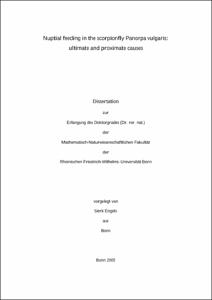Nuptial feeding in the scorpionfly Panorpa vulgarisultimate and proximate causes

Nuptial feeding in the scorpionfly Panorpa vulgaris
ultimate and proximate causes

| dc.contributor.advisor | Sauer, Klaus Peter | |
| dc.contributor.author | Engels, Sierk | |
| dc.date.accessioned | 2020-04-08T01:15:28Z | |
| dc.date.available | 2020-04-08T01:15:28Z | |
| dc.date.issued | 2005 | |
| dc.identifier.uri | https://hdl.handle.net/20.500.11811/2315 | |
| dc.description.abstract | In my thesis I was concerned with ultimate as well as with proximate aspects of nuptial feeding in the scorpionfly Panorpa vulgaris (Mecoptera: Panorpidae). Chapter I begins with the attempt to verify the ultimate function of nuptial gifts in this species. Nuptial feeding is a common strategy shown by males of many insect species. These gifts presented during or after courtship and/or copulation are mostly considered to represent a form of mating effort. During copulations males of P. vulgaris produce salivary secretions which are then consumed by the females. Since females adjust copulation duration and thereby the number of received sperm to the number of salivary masses they receive from a male, the gifts' function as mating effort is unquestionable. Here I present data which indicate that nuptial feeding in P. vulgaris also represents paternal investment. Receiving a high number of salivary masses causes females to lay significantly more eggs compared to females receiving few or no salivary secretions. Thus, in P. vulgaris the nuptial gift increases the reproductive output of females and hence must not only be considered as mating effort but also as paternal investment. However, I cannot decide whether the increase in egg production is caused by an incorporation of additional nutrients or by allohormones. In chapter II I leave the ultimate level to deal with proximate factors affecting salivary gland development and nuptial gift production during matings. In mating systems that are characterised by resource dependent male behaviour like nuptial feeding, food limitation obviously plays a major role in male performance. In P. vulgaris the ability to produce nuptial gifts, however, implies major fitness consequences, as the number of gifts decides about copulation duration. Since the number of transferred sperm increases with ongoing mating duration and sperm of different males are utilised according to the fair raffle principle, nuptial gift production determines male mating success. The results presented in chapter II show that males of P. vulgaris are limited in their production of salivary secretions. The number of saliva secretions males are able to produce declines in successive matings. Moreover, males of nutritionally high status produce more gifts than those of nutritionally low status. The degree of male mating effort corresponds to the size of the salivary gland, yet while absolute investment increases with gland size, the relative investment decreases. Thus, the marginal costs of saliva production are differential for males of different nutritional status. This result provides further evidence of the nuptial gift's function as a Zahavian quality indicator. Furthermore, I found evidence that males of low nutritional status seem to allocate their mating effort strategically according to the female's fecundity. Therefore, cryptic male choice may exist in P. vulgaris, but only below a certain quality threshold of males. In the last experiment, presented in chapter III, I manipulated food availability throughout the animals' entire life history. Here I am concerned with the question whether environmental conditions met during an early phase of life history that is dominated by the natural component of selection will affect traits and behaviour in a sexual selection context later on in life. I once again found strong effects of nutrition during adulthood on various fitness relevant traits (e.g. salivary gland development, saliva investment in copulations). But moreover, I am able to show that food availability during larval development affects male body weight, salivary gland weight before and after a copulation and the proportion of saliva resources that is invested in a mating. Therefore, larval feeding history implies considerable long time consequences and affects several traits that become important in a sexual selection context later on in male life history. | en |
| dc.language.iso | eng | |
| dc.rights | In Copyright | |
| dc.rights.uri | http://rightsstatements.org/vocab/InC/1.0/ | |
| dc.subject | Zooökologie | |
| dc.subject | Evolution | |
| dc.subject | sexuelle Selektion | |
| dc.subject | Paarungsverhalten | |
| dc.subject | Mecoptera | |
| dc.subject | sexual selection | |
| dc.subject | mating behaviour | |
| dc.subject.ddc | 570 Biowissenschaften, Biologie | |
| dc.subject.ddc | 590 Tiere (Zoologie) | |
| dc.title | Nuptial feeding in the scorpionfly Panorpa vulgaris | |
| dc.title.alternative | ultimate and proximate causes | |
| dc.type | Dissertation oder Habilitation | |
| dc.publisher.name | Universitäts- und Landesbibliothek Bonn | |
| dc.publisher.location | Bonn | |
| dc.rights.accessRights | openAccess | |
| dc.identifier.urn | https://nbn-resolving.org/urn:nbn:de:hbz:5N-06133 | |
| ulbbn.pubtype | Erstveröffentlichung | |
| ulbbnediss.affiliation.name | Rheinische Friedrich-Wilhelms-Universität Bonn | |
| ulbbnediss.affiliation.location | Bonn | |
| ulbbnediss.thesis.level | Dissertation | |
| ulbbnediss.dissID | 613 | |
| ulbbnediss.date.accepted | 20.09.2005 | |
| ulbbnediss.fakultaet | Mathematisch-Naturwissenschaftliche Fakultät | |
| dc.contributor.coReferee | Lubjuhn, Thomas |
Files in this item
This item appears in the following Collection(s)
-
E-Dissertationen (4379)




